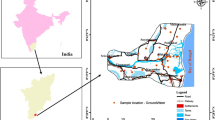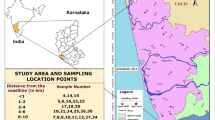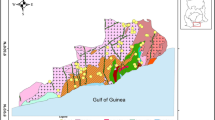Abstract
Purpose
Salinization of groundwater by seawater intrusion is a major concern for the coastal aquifers worldwide. Seawater intrusion occurs mainly due to overpumping of freshwater and sea-level rise which causes lateral and vertical movements of seawater into the coastal aquifers.
Methods
There are several methods to identify and assess the extent of seawater ingress towards land. In the present study, a hydrochemical approach is adopted to understand the status of intrusion. The ions such as Na+, K+, Ca2+, Mg2+, Cl−, SO4 2−, HCO 2−3 , and in-situ parameters namely TDS, pH, and EC were determined for 174 water samples collected both in pre- and post-monsoon in Puducherry region, India.
Results
Ionic ratios such as HCO3 2−/Cl−, Na+/Cl−, Ca2+/Cl−, Ca2+/Na+, Mg2+/Cl−, K+/Cl−, SO4 2−/Cl−, and Cl−/Br− were calculated and correlated with total dissolved solids (TDS) to evaluate seawater intrusion. The ionic ratios such as HCO3 2−/Cl−, Ca2+/Cl−, Mg2+/Cl−, K+/Cl−, and SO4 2−/Cl− vs. TDS shows negative correlation indicating salinization of groundwater. Cl−/Br− ratio is used to distinguish the causes of salinity in groundwater. The Hydrochemical Facies Evolution diagram (HFE-diagram) and heat maps generated out of it have been very well used to understand evolution of seawater intrusion and freshening process in the coastal aquifer to time. The majority of samples in pre-monsoon fall under the facies Na–HCO3/SO4, followed by Na–mixHCO3/mix SO4, Mix Na–HCO3/Mix SO4, and MixNa–MixHCO3/mix SO4 facies indicating direct cations exchange process, whereas, in post-monsoon, Na–Cl, Mix Na–Cl, and Mix Ca–Cl facies are dominant indicating reverse ion exchange process. In the study area, five locations, viz. Ariyankuppam, Kariambattur, Kalapet, Mutialpet, and Parikalpet, fall under Na–Cl and Ca–Cl facies in pre- and post-monsoon which indicates consistent seawater intrusion. The hydrochemical changes that take place during seawater freshwater interaction along coastal aquifer are determined by ionic exchange.
Conclusion
About 24.2% of samples in pre-monsoon and 13.5% of samples in post-monsoon show mixing of seawater. The highly negative ionic exchange values of sodium during pre-monsoon indicate increased amount of seawater fraction in groundwater.








Similar content being viewed by others
References
Amiri V, Nakhaei M, Lak R, Kholghi M (2015) Assessment of seasonal groundwater quality and potential saltwater intrusion: a study case in Urmia coastal aquifer (NW Iran) using the groundwater quality index (GQI) and hydrochemical facies evolution diagram (HFE-D). Stoch Environ Res Risk Assess 30(5):1473–1484. doi:10.1007/s00477-015-1108-3
Anders R, Mendez GO, Futa K, Danskin WR (2013) A Geochemical approach to determine sources and movement of saline groundwater in a coastal aquifer. Groundwater 52(5):756–768. doi:10.1111/gwat.12108
APHA (2005) Standards methods for the examination of water and wastewater, 21st edn. APHA, Washington DC
Appelo C, Postma D (2005) Geochemistry, groundwater and pollution, Second Edn. doi:10.1201/9781439833544
Ayolabi EA, Folorunso AF, Odukoya AM, Adeniran AE (2013) Mapping saline water intrusion into the coastal aquifer with geophysical and geochemical techniques: the University of Lagos campus case (Nigeria). Springer Plus 2(1):433. doi:10.1186/2193-1801-2-433
Barbecot F, Marlin C, Gibert E, Dever L (2000) Hydrochemical and isotopic characterisation of the Bathonian and Bajocian coastal aquifer of the Caen area (northern France). Appl Geochem 15(6):791–805. doi:10.1016/s0883-2927(99)00088-8
Batayneh A, Zaman H, Zumlot T, Ghrefat H, Mogren S, Nazzal Y, Al-Taani A et al (2014) Hydrochemical facies and ionic ratios of the coastal groundwater aquifer of Saudi Gulf of Aqaba: implication for seawater intrusion. J Coastal Res 293:75–87. doi:10.2112/jcoastres-d-13-00021.1
Central Ground Water Board (CGWB) (2007) Groundwater brochure of Puducherry region U.T of Puducherry, pp 1–27. http://www.cgwb.gov.in/District_Profile/Puduchery/Puducherry.pdf
Chen KP, Jiao JJ (2007) Seawater intrusion and aquifer freshening near reclaimed coastal area of Shenzhen. Water Sci Technol Water Suppl 7(2):137. doi:10.2166/ws.2007.048
Christina G, Konstantinos S, Alexandros G, Dimitrios K, Aikaterini K (2014) Seawater intrusion and nitrate pollution in coastal aquifer of almyros–Nea Anchialos Basin, Central Greece
Davis SN, Whittemore DO, Fabryka-Martin J (1998) Uses of chloride/bromide ratios in studies of potable water. Ground Water 36(2):338–350. doi:10.1111/j.1745-6584.1998.tb01099.x
Giménez -Forcada E (2010) Dynamic of sea water interface using hydrochemical facies evolution diagram. Ground Water 48(2):212–216. doi:10.1111/j.1745-6584.2009.00649.x
Giménez-Forcada E (2014) Space/time development of seawater intrusion: a study case in Vinaroz coastal plain (Eastern Spain) using HFE-diagram, and spatial distribution of hydrochemical facies. J Hydrol 517:617–627. doi:10.1016/j.jhydrol.2014.05.056
Gurumoorthy C, Sasidhar P, Arunugham V, Nathur RK (2004) Sub-surface investigations on deep saline ground water of charnokite rock formation, Kalpakkam, India. Environ Monit Assess 91:211–22
Kim J, Kim R, Chang H (2003) Hydrogeochemical characterization of major factors affecting the quality of shallow groundwater in the coastal area at Kimje in South Korea. Environ Geol 44(4):478–489
Kim K-Y, Park Y-S, Kim G-P, Park K-H (2008) Dynamic freshwater–saline water interaction in the coastal zone of Jeju Island, South Korea. Hydrogeol J 17(3):617–629. doi:10.1007/s10040-008-0372-4
Lee J-Y, Song S-H (2006) Evaluation of groundwater quality in coastal areas: implications for sustainable agriculture. Environ Geol 52(7):1231–1242. doi:10.1007/s00254-006-0560-2
Longe EO, Malomo S, Olorunniwo MA (1987) Hydrogeology of Lagos metropolis. J African Earth Sci (1983) 6(2):163–174. doi:10.1016/0899-5362(87)90058-3
McCaffrey MA, Lazar B, Ho HD (1987) The evaporation path of seawater and the coprecipitation of Br− and K+ with Halite. SEPM JSR. doi:10.1306/212f8cab-2b24-11d7-8648000102c1865d
Mondal NC, Singh VS, Saxena VK, Prasad RK (2007) Improvement of groundwater quality due to fresh water ingress in Potharlanka Island, Krishna delta, India. Environ Geol 55(3):595–603. doi:10.1007/s00254-007-1010-5
Mondal NC, Singh VP, Singh VS, Saxena VK (2010a) Determining the interaction between groundwater and saline water through groundwater major ions chemistry. J Hydrol 388(1–2):100–111. doi:10.1016/j.jhydrol.2010.04.032
Mondal NC, Singh VS, Saxena VK, Singh VP (2010b) Assessment of seawater impact using major hydrochemical ions: a case study from Sadras, Tamilnadu, India. Environ Monit Assess 177(1–4):315–335. doi:10.1007/s10661-010-1636-8
Morris AW, Riley JP (1966) The bromide/chlorinity and sulphate/chlorinity ratio in sea water. Deep Sea Res Oceanogr Abstr 13(4):699–705. doi:10.1016/0011-7471(66)90601-2
Moujabber ME, Samra BB, Darwish T, Atallah T (2006) Comparison of different indicators for groundwater contamination by seawater intrusion on the Lebanese Coast. Water Resour Manage 20(2):161–180. doi:10.1007/s11269-006-7376-4
Nair IS, Rajaveni SP, Schneider M, Elango L (2015) Geochemical and isotopic signatures for the identification of seawater intrusion in an alluvial aquifer. J Earth Syst Sci 124(6):1281–1291. doi:10.1007/s12040-015-0600-y
Nwankwoala H, Udom G (2011) Hydrochemical faciès and ionic ratios of groundwater in Port Harcourt, Southern Nigeria. Res J Chem Sci 1(3):87–101
Pulido-Lebeuf P (2004) Seawater intrusion and associated processes in a small coastal complex aquifer (Castell de Ferro, Spain). Appl Geochem 19:1517–1527
Sanchez Martos F, Bosch AP, Calaforra J (1999) Hydrogeochemical processes in an arid region of Europe (Almeria, SE Spain). Appl Geochem 14(6):735–745. doi:10.1016/s0883-2927(98)00094-8
Saxena VK, Singh VS, Mondal NC, Jain SC (2003) Use of hydrochemical parameters for the identification of fresh groundwater resources, Potharlanka Island, India. Environ Geol 44(5):516–521. doi:10.1007/s00254-003-0807-0
Thilagavathi R, Chidambaram S, Prasanna MV, Thivya C, Singaraja C (2012) A study on groundwater geochemistry and water quality in layered aquifers system of pondicherry region, southeast India. Appl Water Sci 2(4):253–269. doi:10.1007/s13201-012-0045-2
Todd DK (1953) Sea-water intrusion in coastal aquifers. Trans Am Geophys Union 34(5):749. doi:10.1029/tr034i005p00749
Acknowledgements
The current work has been supported financially by University Grants Commission, New Delhi [F.No. 41-1035/2012 (SR); Date: 23.07.2012] through major research project. We extend our sincere thanks to Department of Earth Sciences, Department of Ecology and Environmental Sciences and Central Instrumentation Facility of Pondicherry University for providing facilities for analysis. We also extend our thanks to the editor and anonymous reviewer for their valuable suggestions for bringing this research paper to the present level.
Author information
Authors and Affiliations
Corresponding author
Rights and permissions
About this article
Cite this article
Sridharan, M., Senthil Nathan, D. Hydrochemical Facies and Ionic Exchange in Coastal Aquifers of Puducherry Region, India: Implications for Seawater Intrusion. Earth Syst Environ 1, 5 (2017). https://doi.org/10.1007/s41748-017-0006-x
Received:
Accepted:
Published:
DOI: https://doi.org/10.1007/s41748-017-0006-x




